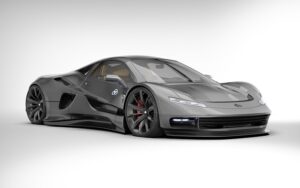Headlights & Lighting
Headlights & Lighting: Illuminating Progress and Shaping the Future
Introduction
In an era where visibility and safety are paramount, headlights and lighting systems have emerged as indispensable components of modern transportation and infrastructure. From the shining beams that cut through the darkness on our roads to the intricate network of urban streetlights, these technologies play a pivotal role in enhancing mobility, securing public spaces, and shaping our daily lives. This comprehensive article aims to unravel the complexities of headlights and lighting, exploring their historical evolution, global impact, technological leaps, regulatory frameworks, and their profound influence on society.
Understanding Headlights & Lighting: A Fundamental Overview
Definition: Headlights and lighting encompass a range of artificial light sources designed to illuminate environments, enhance visibility, and facilitate activities during the night or in low-light conditions. This includes automotive headlights, streetlights, industrial lighting, and various specialized illumination systems.
Core Components: The primary elements include:
-
Light Source: Incandescent bulbs, halogen lamps, LED (Light Emitting Diodes), fluorescent tubes, and gas-discharge lamps are common light sources, each offering unique characteristics in terms of brightness, energy efficiency, and lifespan.
-
Reflectors and Lenses: These components direct and focus the light emitted by the source, ensuring optimal illumination patterns. Reflectors can be parabolic or use more advanced designs for specific applications.
-
Housing and Mounting Systems: Headlights and lighting fixtures are housed in durable materials to protect them from environmental factors and often feature adjustable mounting systems for directionality.
-
Control Mechanisms: These include dimmers, switches, and advanced systems that allow for automated control, such as light-sensitive sensors and motion detectors.
Historical Context: The journey of headlights and lighting began with the invention of the electric lamp in the 19th century by inventors like Thomas Edison and Joseph Swan. Street lighting evolved from gas lamps, which were inefficient and hazardous, to electric streetlights, making urban spaces safer and more vibrant. The automotive industry revolutionized nighttime driving with the introduction of car headlights in the early 20th century, leading to significant improvements in road safety.
Global Impact and Trends
The influence of headlights and lighting is a global phenomenon, shaping urban landscapes, transportation systems, and daily routines worldwide.
| Region | Impact and Trends |
|---|---|
| North America | Known for its advanced automotive lighting technologies, with LED and laser-based headlights gaining popularity. Smart streetlighting systems are being adopted to optimize energy efficiency and public safety. |
| Europe | Leads in sustainable lighting solutions, with a strong focus on reducing carbon emissions. Energy-efficient LED lighting is widely used, and dynamic streetlighting systems adapt illumination based on pedestrian and vehicle movement. |
| Asia-Pacific | Rapid urbanization drives the demand for efficient and smart lighting infrastructure. China, in particular, has made significant strides in solar-powered street lighting and intelligent traffic signalization. |
| Latin America | Focuses on affordable and accessible lighting solutions, with a growing market for off-grid and renewable energy-powered lighting systems due to limited access to traditional electricity networks. |
| Middle East & Africa | Experiences rapid adoption of modern lighting technologies, particularly in urban centers, where smart city initiatives prioritize efficient and safe public lighting. |
Regional variations in climate, infrastructure development, and government policies significantly influence the type and intensity of lighting used, creating a diverse global landscape.
Economic Considerations
The economic implications of headlights and lighting are multifaceted, impacting various sectors:
-
Market Dynamics: The global lighting market is highly competitive, with a mix of traditional lamp manufacturers and new players offering LED and smart lighting solutions. The shift towards energy efficiency and sustainability has driven significant changes in market dynamics.
-
Investment Patterns: Governments worldwide invest heavily in public lighting infrastructure, with smart city projects often prioritizing efficient streetlighting systems. Private sector investments in lighting technologies focus on innovation, energy savings, and return on investment.
-
Impact on Economic Systems: Efficient lighting practices can substantially reduce energy consumption and associated costs, benefiting businesses and households. Well-lit urban spaces enhance economic activities, making them more attractive for retail, tourism, and entertainment.
Technological Advancements
The field of headlights and lighting has witnessed remarkable technological breakthroughs:
-
LED Revolution: Light Emitting Diodes (LEDs) have revolutionized the industry due to their energy efficiency, longevity, and versatility. LED headlights offer superior brightness with reduced power consumption, making them a popular choice for automotive and public lighting applications.
-
Laser Technology: Laser-based headlights are emerging as the next big thing in automotive lighting, providing unparalleled intensity and focus. They promise improved road illumination and safety, especially in low-light conditions.
-
Smart Lighting Systems: Internet of Things (IoT) enabled smart lighting offers automated control, energy management, and advanced safety features. These systems can adapt light output based on ambient conditions, occupancy, and time of day, significantly reducing energy consumption.
-
Solar and Renewable Energy: Integrating solar panels into streetlights and off-grid lighting systems is gaining traction, offering sustainable solutions for remote areas with limited access to electricity grids.
Policy and Regulation
Governments worldwide play a crucial role in shaping the lighting landscape through various policies and regulations:
-
Energy Efficiency Standards: Many countries have implemented strict energy efficiency standards for lighting products, encouraging the use of LED and other efficient technologies. These standards often include labeling systems to help consumers make informed choices.
-
Road Safety Regulations: Automotive headlights and lighting systems are subject to stringent regulations to ensure driver visibility and road safety. These regulations dictate minimum light output, beam patterns, and headlight positioning.
-
Public Lighting Policies: Urban areas have specific policies regarding streetlight design, placement, and energy usage. Some cities mandate the use of smart lighting systems to optimize energy efficiency and reduce maintenance costs.
-
Environmental Regulations: The growing concern for environmental protection has led to regulations addressing waste management, recycling, and the eco-friendly disposal of lighting products.
Challenges and Criticisms
Despite its numerous benefits, the headlights and lighting industry faces several challenges:
-
Energy Consumption Concerns: Traditional lighting systems are significant energy consumers, leading to critics emphasizing the need for more efficient alternatives. The transition to LED and other efficient technologies has been gradual due to initial cost barriers.
-
Light Pollution: Uncontrolled lighting in urban areas contributes to light pollution, affecting ecosystems, wildlife behavior, and human health. Excessive or poorly designed street lighting can also create visual pollution, distracting drivers and impacting the aesthetic appeal of cities.
-
Accessibility and Affordability: In developing regions, access to modern lighting technologies is limited for low-income communities due to cost constraints. Ensuring affordable and accessible lighting solutions remains a challenge.
Proposed Solutions: To address these issues, policymakers can offer incentives for adopting energy-efficient lighting, implement stricter light pollution regulations, and promote public-private partnerships for infrastructure development. Innovation in technology, such as improving LED efficiency and reducing production costs, is crucial to overcoming affordability barriers.
Case Studies: Successful Applications and Lessons Learned
1. Smart City Lighting in Copenhagen, Denmark
Copenhagen’s streetlighting transformation is a shining example of urban lighting innovation. The city replaced traditional sodium lamps with energy-efficient LED lights, creating a more vibrant and safer urban environment. The project included smart controls that dimmed lights during the day and adjusted brightness based on pedestrian movement, reducing energy consumption by 50%. This case highlights the positive impact of smart lighting systems on both energy efficiency and public safety.
2. LED Headlights in Modern Automotive Design
The automotive industry has embraced LED headlights en masse, offering improved visibility and styling options. Manufacturers like Tesla have pushed the boundaries with advanced laser-based headlights, providing exceptional range and clarity. This case study demonstrates how technological advancements in headlights enhance driver safety and contribute to a more appealing design aesthetic.
3. Solar Street Lighting in Rural India
In remote villages across India, solar-powered streetlights have brought about significant changes. These off-grid lighting solutions provide reliable illumination without the need for connection to central electricity grids. The implementation of these lights has improved safety, encouraged economic activities, and empowered communities with access to modern amenities. This case illustrates the potential of renewable energy in transforming lighting infrastructure in underserved regions.
Future Prospects: Trends and Growth Areas
The future of headlights and lighting is promising, shaped by emerging technologies and evolving needs:
-
Smart Lighting Integration: The integration of smart lighting systems will continue to grow, with more cities adopting IoT-enabled lights for energy management and public safety.
-
Autonomous Vehicle Headlights: With the rise of autonomous vehicles, headlights will play a crucial role in advanced driver-assistance systems (ADAS). Adaptive headlights that adjust to surrounding conditions and pedestrian detection will become standard features.
-
Dynamic Lighting Applications: Dynamic lighting systems that change color and intensity based on user preferences, weather, or traffic conditions will gain popularity. These systems offer personalized experiences and improved safety.
-
Renewable Energy Dominance: The push for sustainable energy sources will drive the adoption of solar, wind, and other renewable energy technologies in lighting infrastructure, especially in off-grid and remote applications.
Conclusion: Illuminating a Brighter Future
Headlights and lighting are more than just functional elements; they shape our daily lives, impact public safety, and contribute to sustainable development. From the headlamps that guide us on dark roads to the vibrant streetlights that line our cities, these technologies have evolved significantly, driven by innovation and a growing awareness of energy efficiency and environmental concerns.
The global landscape is characterized by diverse trends and challenges, with regions leading in specific areas such as smart city initiatives or sustainable lighting solutions. As technology advances, we can expect headlights and lighting to play even more critical roles in our lives, from enhancing driver safety to fostering vibrant urban communities.
By addressing the challenges, embracing new technologies, and implementing thoughtful policies, the industry can continue to illuminate a brighter and safer future for all. This article offers a comprehensive overview, but the story of headlights and lighting is an ever-evolving narrative, constantly being written by inventors, policymakers, and innovators worldwide.
FAQ Section: Quick Answers to Common Questions
Q: How do LED lights compare to traditional incandescent bulbs?
A: LEDs offer significant advantages over incandescent bulbs, including higher energy efficiency (using up to 80% less energy), longer lifespans (up to 25 times longer), and reduced heat generation. They also come in various colors and can be easily dimmed.
Q: What are the benefits of smart streetlights?
A: Smart streetlights provide energy savings through automated control, adjusting brightness based on demand. They offer improved safety with real-time monitoring and can be integrated with city management systems for efficient maintenance. Additionally, they contribute to reduced light pollution and better urban aesthetics.
Q: How do laser headlights improve road safety?
A: Laser headlights produce a tighter and more focused beam, offering superior illumination of the road surface and nearby obstacles. This improved visibility enhances driver awareness, especially in low-light conditions, leading to safer driving experiences.
Q: What role does government play in promoting energy-efficient lighting?
A: Governments play a pivotal role through policies and incentives. They set energy efficiency standards, offer tax benefits for adopting efficient lighting, and fund research and development initiatives. Many countries also implement public awareness campaigns to educate consumers about the benefits of energy-efficient lighting choices.

Register Car California: Step-by-Step DMV VIN Verification
Looking to register your car in California? This comprehensive guide breaks down the process step-by-step, ensuring a smooth experience. From…

Register Car: Prepare, Visit DMV, Verify VIN, Pay Fees
Looking to register your car in California? This comprehensive guide walks you through the process, ensuring a smooth experience. From…

Registering a Car in California: DMV Steps & VIN Verification
Looking to register your car in California? This comprehensive guide walks you through every step, from understanding key requirements to…

Register Car California: Step-by-Step VIN Verification Guide
Looking to register your car in California? Navigating the process can be straightforward with the right preparation. This guide breaks…

Register Car California: Step-by-Step with VIN Verifier
Looking to register your car in California? This comprehensive guide walks you through every step, from understanding crucial requirements to…

Register Car California: Use VIN Verifier Effortlessly
Looking to register your car in California? This comprehensive guide breaks down the process step-by-step. From understanding vital registration requirements…

Register Car California: Step-by-Step Guide to DMV Vin Verification
Looking to register your car in California? This comprehensive guide walks you through every step, from understanding crucial requirements to…

Register Car California: VIN Verifier Guide for Success
Looking to register your car in California? This comprehensive guide walks you through the entire process, ensuring a smooth experience.…

Register Car California: VIN Verifier Essentials
Looking to register your car in California? This comprehensive guide walks you through every step, from understanding crucial requirements to…

Register Car California: VIN Verification, DMV Steps
Looking to register your car in California? This comprehensive guide walks you through the process, ensuring a smooth experience. From…